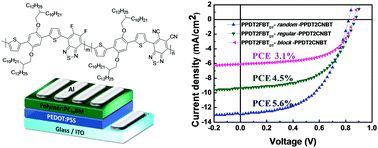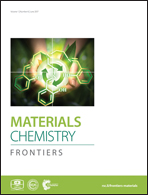Synthesis and photovoltaic properties of three different types of terpolymers†
Abstract
Three types of photoactive terpolymers (Random, Regular and Block) were synthesized by incorporating two electron-deficient moieties and one electron-rich moiety based on two parent donor polymers, poly[(2,5-bis(2-decyltetradecyloxy)phenylene)-alt-(5,6-difluoro-4,7-di(thiophen-2-yl)benzo[c][1,2,5]thiadiazole)] (PPDT2FBTDT) and poly[(2,5-bis(2-decyltetradecyloxy)phenylene)-alt-(5,6-dicyano-4,7-di(thiophen-2-yl)benzo[c][1,2,5]thiadiazole)] (PPDT2CNBT). All three terpolymers showed broad light absorption in the range of 300–850 nm covering the absorption of two parent polymers. Their optical, electrochemical, morphological and photovoltaic properties were compared and investigated in detail. Power conversion efficiencies (PCEs) of 5.63, 4.45 and 3.13% were obtained for PPDT2FBTDT-random-PPDT2CNBT, PPDT2FBTDT-regular-PPDT2CNBT and PPDT2FBTDT-block-PPDT2CNBT based photovoltaic devices, respectively. Through intensive investigation on charge carrier mobility, photocurrent and light intensity dependence of JSC, the random structure was proved to be the most effective molecular design in this series of terpolymers, showing weaker charge recombination and enhanced charge transport/extraction with well-distributed blend morphology. The fine modulation of different arrangements and compositions of the three monomers in a main chain is crucial for optimizing the terpolymeric structures as efficient photoactive materials.

- This article is part of the themed collections: Materials Chemistry Frontiers HOT articles for 2017 and Next-Generation Organic/Hybrid Photovoltaics


 Please wait while we load your content...
Please wait while we load your content...